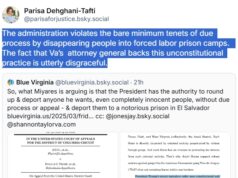by Virginia State Senator Dave Marsden (D-Fairfax)
I read with interest a letter sent to Governor Northam by a number of my colleagues encouraging the Governor to begin releasing a number of adult inmates in the Department of Corrections (DOC) facilities and juvenile wards in the Department of Juvenile Justice (DJJ) secure confinement facilities. Many of their suggestions are reasonable and worth pursuing. My concern is that the letter understates the difficulty of accomplishing this responsibly.
While I am not an infectious disease expert, I do have experience in dealing with emergencies in correctional facilities as the Superintendent of the Fairfax County Juvenile Detention Center for 17 years, followed by 2 ½ years as Chief Deputy and Acting Director of Virginia’s Department of Juvenile Justice (DJJ). For the past 18 years, I have consulted in dozens of states for the US Department of Justice and directly with states and localities around community violence reduction as well as security and operational issues in juvenile and adult corrections facilities. I did not sign on to this letter, because I knew that plans were in place to deal with the pandemic as it impacted prisons, local and regional jails, local juvenile detention centers and the last remaining secure commitment facility in DJJ. Therefore, I contacted the Director of DJJ several weeks ago and the Director of DOC today, Easter Sunday, to determine what is being done.
So, let’s start with DOC.
The Virginia DOC currently operates 46 confinement facilities, of which four have inmates diagnosed with Covid-19. There are 33 combined cases identified in these facilities as of April 13. Eight of them have been returned to non-positive for Covid-19 status. The number of infections is not dramatically increasing at this point.
Parole was eliminated in 1995 in Virginia, and only those sentenced prior to 1995 are still eligible for parole. Many have been paroled. Those who have not been, after 25 years, are still considered dangerous based on their performance while incarcerated or the horrendous nature of their offense. A law passed this year to deal with what are called Fishback cases will be an exception to the no-parole law. These are individuals who were sentenced with their juries not being advised that parole had been abolished, leading to juries believing that they could hand down long sentences in the belief that they would be parole eligible after completing 25% of their sentence. There is also a provision in state law for geriatric release after age 60. Also, under a bill I passed this year, an inmate sentenced to serve an adult life sentence while they were a juvenile will be eligible for parole after 20 years of confinement. This does not take effect until July 1, but preliminary work can be done by the Parole Board on these approximately 170 cases in anticipation of that date – if they have the capacity during this stressful time.
Jail inmates usually are under the jurisdiction of their sentencing judge, and local sheriffs have the authority to allow early release. These jails are located closer to the communities they serve. Inmate reduction for the coronavirus concern involves less serious offenders and they have lawful flexibility for accelerated or immediate release. It is not as easy for DOC, which has far more serious and potentially dangerous inmates. Here are some of the problems DOC will have in releasing inmates as outlined in the letter.
- The Parole Board is responsible for investigating and evaluating pardon or reduced sentence requests. It takes months to do this properly. That could be accelerated, but only up to a point.
- Parole does not exist and the planned amendments to HB 29 at the April 22 Veto Session, the caboose bill that takes us to this July 1, to expedite early conditional release under the Governor’s authority, will still be bound by existing Virginia code requiring release planning and an approved place to reside upon release for those eligible. DOC does have authority to release early, but only 30 days prior to mandatory release. This is already being done.
- Inmates may be safer where they are, depending on the type of facility they are housed in. Dormitory facilities are more conducive to disease transmission than single or double room facilities. These single/double room facilities are easy to disinfect due to the predominance of hard smooth surfaces, and social distancing can be enforced by facility rule and “direct supervision.”
- Inmates often do not have homes to return to, or families who will accept them, due to the problems they have had with family interactions in the past. Also, 76% of inmates have histories of violence, making release placement even more difficult. Homeless shelters are not acceptable release options under normal circumstances. They are prohibitive in a pandemic.
- Inmates are in prison because of poor decision making, and they continue with thinking errors in far greater numbers than the general population. If you can find a place to release them, they are likely to violate stay-at-home restrictions, if still in place, because they do not make good decisions. The pull of the street, if you will, will be powerful. Parole Officers will be stretched and unable to provide adequate supervision over those released, as the newly released are likely be unemployed, restless and unlikely to abide by the new norms of the Covid-19 era.
- Their behavior may make them more vulnerable to becoming infected and lacking the internal controls that would prevent them from infecting others.
- Vulnerable geriatric inmates are currently hard to place. Family is mostly not an option. They have significant health issues, and nursing homes or adult care facilities are reluctant to take them in normal times. Currently, these resources are locked down and not taking new residents. Also, the geriatric inmates are unlikely to find employment easily, and may not want to leave prison – as it is the only existence they know. Also, releasing inmates who may need medical help during a surge in hospital bed need could be irresponsible. Hospitals are also risky to be placed in for regular medical services during this crisis.
- Mental health and substance abuse services will be difficult to provide and will create circumstances where released inmates will deteriorate, be exposed to the virus, violate release conditions, re-offend and have to be placed in confinement, exacerbating the Covid-19 dilemma. And this will occur at a time when the judicial system has a vastly reduced capacity to deal with these issues.
There are certainly a number of inmates who can be safely released, and DOC is working to accomplish that goal. Attached to this letter is the eighth version of the DOC pandemic emergency plan created to deal with this crisis. Now, on to DJJ.
DJJ operates under different laws, rules and practices. Juvenile parole was never eliminated. They have had some cases of youth who exhibited a fever and were tested positive. All have been isolated and show no signs of illness after that initial fever. They have had some staff members test positive as well. They take temperatures of facility residents twice per day, and matters appear stable as of this date. DJJ is taking steps to release those that they can release responsibly, but remember several things:
- A significant number (50 or so) of the 200 held at the Bon Air facility are youth serving what is called a blended sentence, and will be transferred to an adult facility prior to their 21st birthday to complete their sentence begun at DJJ. Judges have determined that it is best that they start their adult sentence at a DJJ facility, as this will be better for their safety, rehabilitative treatment, and educational needs.
- When I finished my stint as Director of DJJ in 2002, we had 1,150 or so youth in eight facilities. We had group homes for gradual reentry and a generally less serious population of young offenders. Juvenile Justice practice has evolved greatly since then, and we now keep youth out of secure confinement through risk instruments that determine a youth’s level of danger to public safety and treatment need. We keep juvenile offenders out of secure detention and DJJ commitment facilities unless they represent an unacceptable threat. It makes for better outcomes for these individuals and less crime. Therefore, youth in DJJ custody have more serious behavioral, mental health and substance abuse issues than in previous years. As a result, there are only 325 youth in DJJ custody today, and many (125 or so) have been placed in local detention home programs at DJJ expense and under DJJ supervision. Closer to home has many benefits. The Bon Air Juvenile Center is the only secure juvenile facility left in the system, and they house the most severe youth. There are 200 youth at the facility, which is well below their capacity.
- The 325 youth in all secure confinement in Virginia have significant issues, as few youths are now committed who have only moderate delinquent profiles. They are more likely to be serious offenders, with mental health issues and other deficits that make their behavior hard to predict. DJJ is currently not taking new commitments, and local judges are putting youth in local detention only if absolutely necessary for public safety.
Both DOC and DJJ are acting in the best interest of individuals confined in their secure facilities. They are executing carefully thought-out plans. They are not perfect agencies (I have issues with both agencies from time to time). But they are professionally run, forward-thinking operations. I have been contacted by numerous adult inmates. Some of them have legitimate concerns, while others are using the virus as a means of manipulating their release. Can’t blame them for trying, but they are currently likely to be as safe as anyone where they currently reside in this difficult time. That could change, but right now the DOC and DJJ have strong pandemic plans in place.
Before we hit the panic button and start a disorganized and frenetic protocol for releasing the incarcerated, let’s let these state agencies do their jobs as they execute their pandemic emergency plans. The situation appears to be under control for now, and releasing people prematurely can actually create greater danger for them and for all of us as well. They are currently safe, have proper medical care, treatment services, supervision, and no outbreak at this time that is not manageable.
I appreciate the concern that my colleagues, and for the drafter of the letter at the Legal Aid Justice Center, are expressing for these individuals. But I also believe that the administration has an adequate handle on the situation and is making good decisions in providing for the safety those they have responsibility for. As their experience changes and updated data indicates more aggressive actions, I think they should carry on with their current pandemic plan. I have confidence that they have the knowledge, skills and abilities to do what is necessary – by either staying the course, or by shifting into a more accelerated release protocol if the situation changes.



 Sign up for the Blue Virginia weekly newsletter
Sign up for the Blue Virginia weekly newsletter
![Video: Mother of Timothy McCree Johnson Says “Gov. Youngkin’s Actions [in Pardoning Police Officer Who Shot Her Son] Are Egregious, Malicious and Prejudiced”; Adds, “if this is the legacy that Gov. Youngkin wants to leave behind, then so be it – that’s also between him and his god.”](https://bluevirginia.us/wp-content/uploads/2025/03/shifflettmother-238x178.jpg)





![Monday News: “US popularity collapses worldwide in wake of Trump’s return”; “Trump defends the [indefensible] prospect of Qatar gifting him a plane to use as Air Force One”; Trump Removes Tariffs After Adding Tariffs After…; “Is Jeff Bezos Ruining the [WaPo]?”](https://bluevirginia.us/wp-content/uploads/2025/05/montage0512-100x75.jpg)
